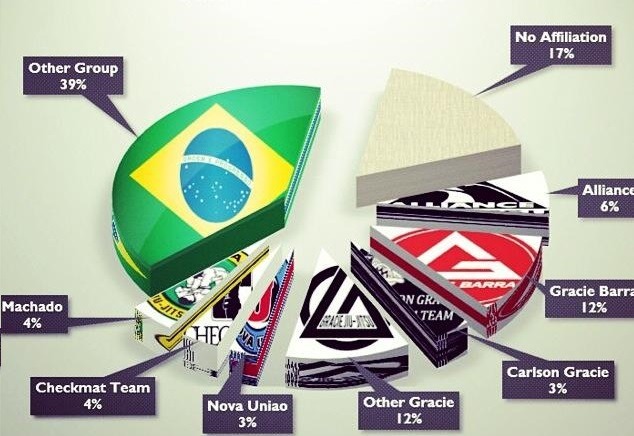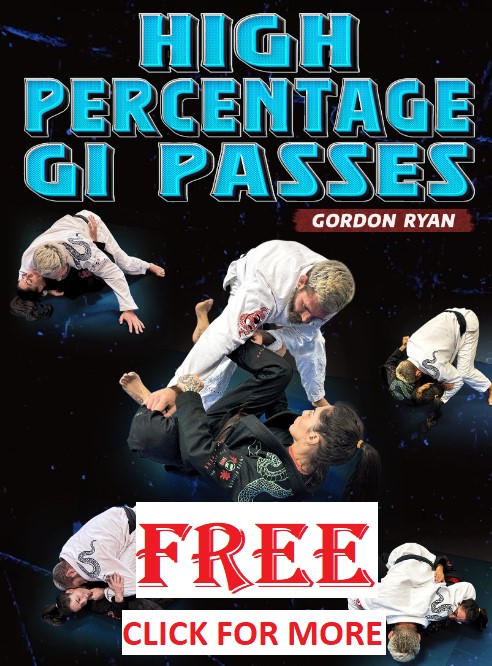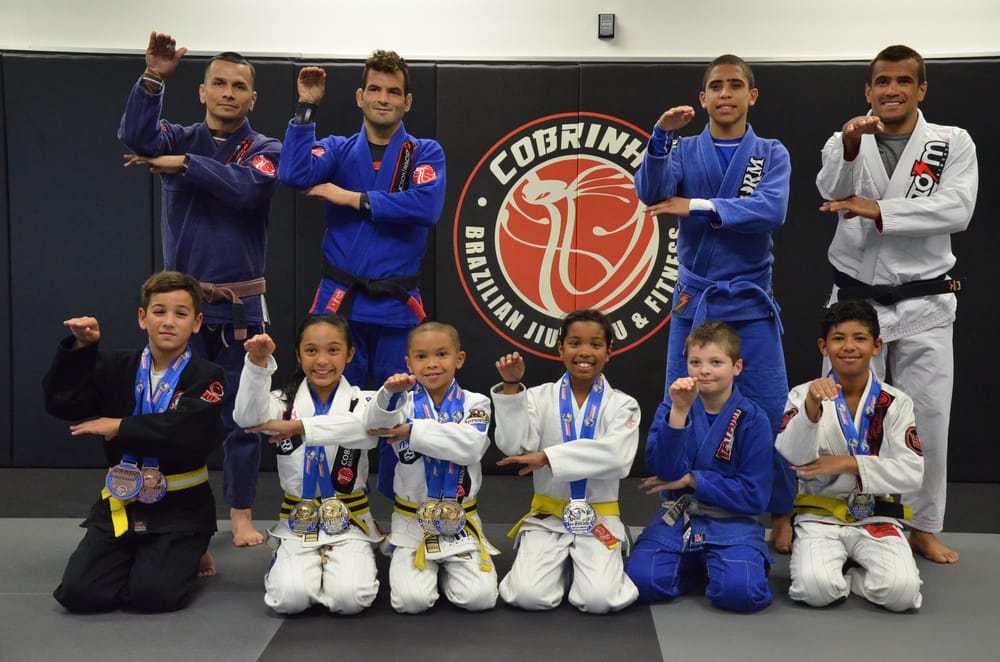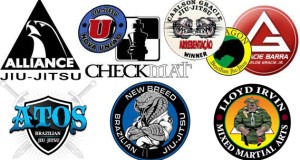
When you first take a look at Brazilian Jiu-Jitsu, you get the impression that is a highly individual sport. Nothing can be further from the truth. Although individuality is a huge part of Jiu-Jitsu, it is not the defining trait of the sport. The most obvious moment is training. Unlike their striking counterparts, grappling martial arts cannot be trained alone. The only thing a grappler can do without a partner is drilling certain moves. However, in order to truly train grappling, you need a partner. Actually, you need more than one in order to progress. Competition-wise, the importance of having like-minded training partners is even more important. That’s the reason people usually congregate in BJJ teams for tournament preparation.
Even though competitive BJJ teams are mostly aimed at preparing for tournaments, they turn out to provide much bigger benefits for grapplers. In a competitive environment, teams usually stick together and corner every member for every match. Given enough time, people in teams inevitably become friends off the mats as well as on them. A strongly knit BJJ team usually means you have friends for life that offer support in every possible way. But what is it that makes a BJJ team such a positive influence? How do you know if you’re in the correct team environment for you? Is a bigger or smaller team a better fit for you? Let’s try and answer all of these questions.
The Role Of BJJ Teams
Despite individuality being the driving factor behind BJJ innovation, Jiu-Jitsu can be considered a team sport. Team presence is extremely notable at every BJJ tournament you go to. Everywhere you turn you’re exposed to t-shirts, hoodies, Gi patches etc. all demonstrating affiliation to different BJJ teams. Some of the major BJJ teams or those most enthusiastic about competing even have team flags that they proudly display. All these team “colors” are always passionately defended and relentlessly promoted.
The reasoning behind this mentality is the sense of belonging that a team environment offers. BJJ teams are friendly, family-like environments that offer inclusion and warmth. Team mentality can range from just a group of people that drill together to a cult-like devotion. Both have certain traits in common. For one, they offer consistency. Large teams with a worldwide reach, provide the option to train everywhere that you are and feel right at home. This is priceless for someone getting ready to grapple at a BJJ tournament. This kind of consistency that BJJ teams offer is the reason behind the success of many of the top world champions.
Furthermore, BJJ teams offer valuable resources to all members. Instructors, facilities, training partners and training schedules offer the opportunity to students of all levels to prepare as best as possible. The more people you train with on a regular basis, the better you’ll become. Now, if those people are like-minded in preparing for tournaments, you have the perfect environment to thrive. BJJ teams give access to more people that often turn to be valuable contacts off the mats.
Finally, there’s a feeling of loyalty. People are usually fiercely loyal to their teams which can be a double-edged sword. Loyalty can bring a team together or down, depending on the circumstances.
The BJJ Teams To Avoid
The defining characteristic of a BJJ team depends on the type of individuals in it. A BJJ team is only as good (or bad) as the people in it. Some of the same issues that trouble other groups in society are also present in BJJ teams. Despite the ability of Jiu-Jitsu to weed out bullies, they manage to make their way on the mats. Having a bully on the team, especially one that’s highly ranked can be a real problem. usually, the instructor is the one to deal with this, but in instances where he/she is the bully, the whole team is going to suffer.
One huge sign to stay away from a team is the “McDojo” mentality. To put it simply, if you find yourself having to pay for anything and everything, then you’re part of a scheme instead of a team. The most prevalent activity in McDojos is belt selling, which waters down the quality of a “team” from the start. Next, having to buy all kinds of training gear, from Gis to T-shirts just in order to train is not how a team should be organized. Remember that cult-like behavior we mentioned earlier? Well, that’s exactly the commitment that a McDojo is going to require from you. Stay away from McDojos if you’re really looking to become a fierce grappling competitor.
Another big and pressing issue is that of sexual harassment. There have been a few instances lately of this kind of behavior associated with Brazilian Jiu-Jitsu. To be clear, sexual harassment has no place in any kind of sport and should be condemned by everyone. Regardless of sex, if this happens in a team, you should leave immediately and consider going to the authorities.
The Relevance Of Team Size
With the growth of BJJ as a sport, teams around the world have also grown in size. today, you can find BJJ teams of all sizes around the globe. From a few men local teams to worldwide organizations like Gracie Barra, the team structure is present in grappling. Both these examples offer up different opportunities for people involved in the respective BJJ teams.
Smaller-sized BJJ teams are those that rarely have more than one gym, and have a total member count of a maximum of 50 people. They usually do not extend past a city or a country. To begin with, there’s no reason to think that smaller teams have fewer chances of winning at tournaments. A team built of good people is always going to have the chance to breed world champions, regardless of size or reach.
The good sides of a small team are that you can get a lot of attention from instructors since there aren’t that many people around. You also get to roll with the instructor on a regular basis, due to the same reason. Smaller teams are tight groups that offer a very strong bond. On a negative note, smaller teams have no affiliates for people that travel often to train with. Another downside is rolling with the same few people over and over again and not getting exposed to different styles.
Larger teams are those like Gracie Barra, Alliance, Athos, Checkmat GFT, etc. They extend across continents, having multiple academies per country and/or city and hundreds or even thousands of members. They offer experience, a huge network of resources, and lots of different training partners and styles. Where they lack is individual attention as well as ending up competing against teammates due to the overwhelming presence in numbers at tournaments.
In Summary
Choosing academies to train in can be a difficult job sometimes. Given that we live in an imperfect world where 90% of academies do not adhere to either the curriculum or the way techniques are done, nor do they follow the very principle of operation of academies that these same academies do not impose on them. An even bigger problem happens that belts are obtained on the basis that you see the person who gives you a black belt once or possibly twice in your life unless you train at their home academy. When you add it all up and subtract it, we come to the conclusion that a lot of academies, even over 90%, no matter what sign they have in front of the name, work as they please and do not reflect the position of their supreme academy whose name they bear.
https://bjj-world.com/the-best-jiu-jitsu-mats/


![Darce Choke Encyclopedia – Origins, Mechanics and Variations [2024] BJJ, choke, Brabo, BJJ Darce Choke, D'arce Choke, Darce BJJ Choke](https://bjj-world.com/wp-content/uploads/2017/11/JungPoirierLeeYahoo-218x150.jpg)











![Essential Shin To Shin System Shawn Williams DVD Review [2025] Essential Shin To Shin System Shawn Williams DVD Review](https://bjj-world.com/wp-content/uploads/2025/01/shin-to-shin-system-shawn-williams-dvd-review-218x150.png)


![Creating Back Exposure Luke Griffith DVD Review [2025] Creating Back Exposure Luke Griffith DVD Review](https://bjj-world.com/wp-content/uploads/2025/01/creating-back-exposure-luke-griffith-dvd-review-218x150.png)
![Wristlocks From The Top Pete Letsos DVD Review [2025] Wristlocks From The Top Pete Letsos DVD Review](https://bjj-world.com/wp-content/uploads/2025/01/wristlocks-from-the-top-pete-letsos-dvd-review-218x150.png)
![The Closed Guard Malachy Friedman BJJ DVD Review [2025] The Closed Guard Malachy Friedman BJJ DVD Review](https://bjj-world.com/wp-content/uploads/2025/01/closed-guard-malachy-friedman-bjj-dvd-review-218x150.png)












![Advanced Immortal Clinch Matt Brown DVD Review [2024] Advanced Immortal Clinch Matt Brown DVD Review](https://bjj-world.com/wp-content/uploads/2024/09/advanced-immortal-clinch-matt-brown-dvd-review-100x70.png)
![Daisy Fresh WHITE BELT Wrestling Curriculum DVD Review [2024] Daisy Fresh WHITE BELT Wrestling Curriculum DVD Review](https://bjj-world.com/wp-content/uploads/2024/10/daisy-fresh-white-belt-wrestling-curriculum-review-100x70.png)
![Wrestling For Jiu-Jitsu Shawn Williams DVD Review [2025] Wrestling For Jiu-Jitsu Shawn Williams DVD Review](https://bjj-world.com/wp-content/uploads/2025/01/wrestling-for-jiu-jitsu-shawn-williams-dvd-review-100x70.png)
![Tricks for Unstoppable Takedowns Georges St Pierre DVD Review [2024] Tricks for Unstoppable Takedowns Georges St Pierre DVD Review](https://bjj-world.com/wp-content/uploads/2024/12/unstoppable-takedowns-georges-st-pierre-dvd-review-100x70.png)

![Slip N Slide Into Victory Julián Espinosa DVD Review [2025] Slip N Slide Into Victory Julián Espinosa DVD Review](https://bjj-world.com/wp-content/uploads/2025/01/slip-n-slide-into-victory-julian-espinosa-dvd-review-100x70.png)
![The Whole Omoplata Enchilada Lyanne Perez DVD Review [2024] The Whole Omoplata Enchilada Lyanne Perez DVD Review](https://bjj-world.com/wp-content/uploads/2024/11/whole-omoplata-enchilada-lyanne-perez-dvd-review-100x70.png)



![How to Double Leg Anyone Kevin Lee DVD Review [2024] How to Double Leg Anyone Kevin Lee DVD Review](https://bjj-world.com/wp-content/uploads/2024/11/how-to-double-leg-anyone-kevin-lee-dvd-review-100x70.png)
![Advanced Chin Control Concepts David Petrone DVD Review [2025] Advanced Chin Control Concepts David Petrone DVD Review](https://bjj-world.com/wp-content/uploads/2025/01/chin-control-concepts-david-petrone-dvd-review-100x70.png)



![10th Planet Leg Locks Jeremiah Vance DVD Review [2025] 10th Planet Leg Locks Jeremiah Vance DVD Review](https://bjj-world.com/wp-content/uploads/2025/01/10th-planet-leg-locks-jeremiah-vance-dvd-review-100x70.png)
![The Rack Kyle Watson BJJ DVD Review [2025] The Rack Kyle Watson BJJ DVD Review](https://bjj-world.com/wp-content/uploads/2024/12/the-rack-kyle-watson-bjj-dvd-review-100x70.png)